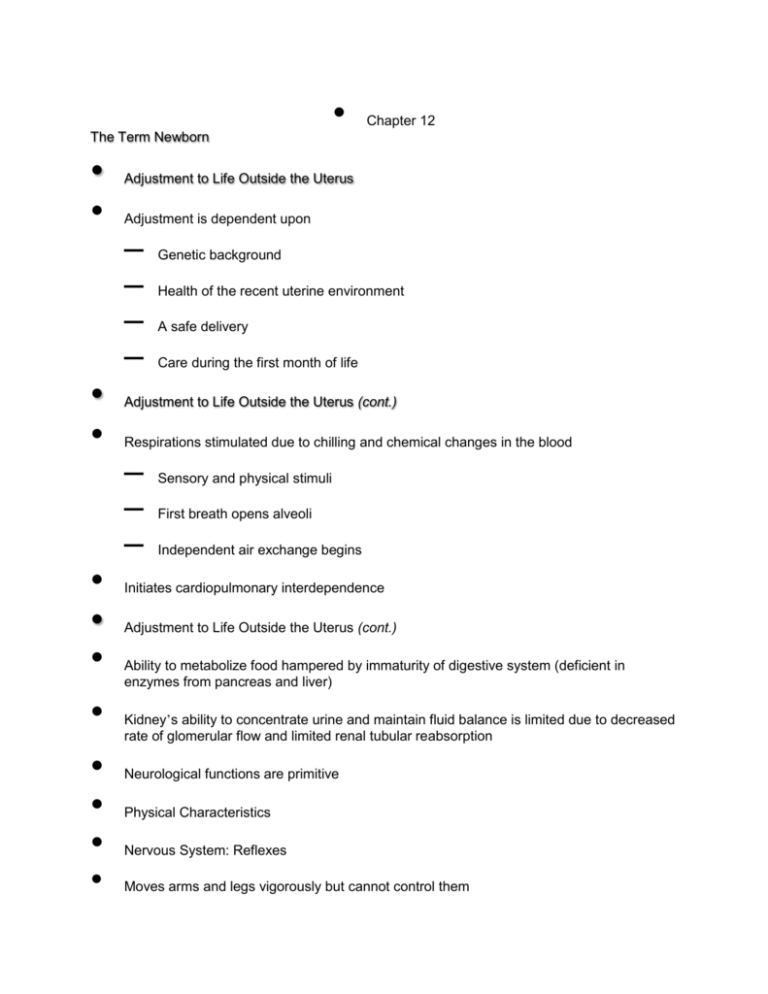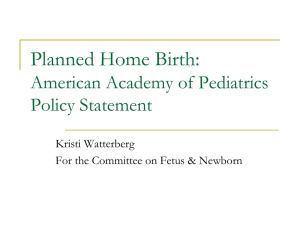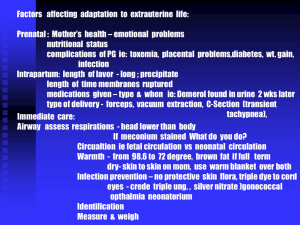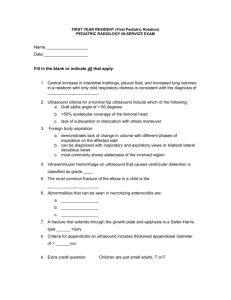Chapter 12 The Term Newborn Adjustment to Life Outside the
advertisement

The Term Newborn • • • • • • • • • • • • • Chapter 12 Adjustment to Life Outside the Uterus Adjustment is dependent upon – – – – Genetic background Health of the recent uterine environment A safe delivery Care during the first month of life Adjustment to Life Outside the Uterus (cont.) Respirations stimulated due to chilling and chemical changes in the blood – – – Sensory and physical stimuli First breath opens alveoli Independent air exchange begins Initiates cardiopulmonary interdependence Adjustment to Life Outside the Uterus (cont.) Ability to metabolize food hampered by immaturity of digestive system (deficient in enzymes from pancreas and liver) Kidney’s ability to concentrate urine and maintain fluid balance is limited due to decreased rate of glomerular flow and limited renal tubular reabsorption Neurological functions are primitive Physical Characteristics Nervous System: Reflexes Moves arms and legs vigorously but cannot control them • • • • • • • • • • • • • Full-term infants are born with the following reflexes (which help keep them alive) – – – – – Blinking Sneezing Gagging Sucking Grasping They can also cry, swallow, and lift their head (slightly) when lying on their abdomen Reflexes Moro Rooting Tonic neck Dancing Head Molding from delivery process – – May have swelling of the soft tissues of the scalp, called caput succedaneum May see a cephalhematoma—a collection of blood beneath the periosteum of the cranial bone • Does not cross the suture line Fontanels (soft spots) protect the head during delivery and allow further brain growth Visual Stimuli and Sensory Overload Can see and fixate on points of contrast – Toys with contrasting colors or those that make noise attract the newborn’s attention Tears are absent until 1 to 3 months of age • • • • • • • • • • • • • Sensory overload can occur if there is too much detrimental stimulation Important for the nurse to keep surrounding environment as calm and quiet as possible, no bright lighting or loud alarms Hearing Ears well-developed, but small Hearing ability present at birth (sick or premature newborn may not respond to sounds) Normal drainage and sneezing occurs after birth to rid ear canals of amniotic fluid May react to sudden sounds by increased pulse or respiratory rate or startle reflex Responds to voices by decreasing motor activity, sucking activity, and turning head toward the sound Hearing screening performed before discharge Sleep 15 to 20 hours per day Phases of sleep-wake cycle – – – – First reactive Sleep Second reactive Stability Specific pattern of reactivity that can influence the response to stimuli and bonding – – – – Quiet sleep Rapid eye movement (REM) sleep Active alert Quiet alert • • • • • • • • • • • • • • • • – – Crying Transitional Pain Produces catecholamines and cortisol – – Heart and respiratory rates change Blood pressure increases as does blood glucose levels Untreated pain can have long-term effects – Pain pathways and structures required for long-term memory are well developed by 24 weeks gestation Unrelieved pain can cause exhaustion, irritability, and delay the healing process Pain Assessment Tools COMFORT CRIES FLACC PIPP NIPS NPASS Conditioned Responses A response of reflex that is learned over time Example is a hungry infant stops crying when it hears its mother’s voice, even though food is not available Emotions particularly subject to this type of conditioning Neonatal Behavioral Assessment Scale • • • • • • • • • • • Measures inherent neurological capacities and response to selected stimuli Areas tested include – – – – – Alertness Response to visual and auditory stimuli Motor coordination Level of excitement Organizational process in response to stress Respiratory System Once umbilical cord is clamped and cut, the lungs take on the function of breathing oxygen and removing carbon dioxide – – First breath helps to expand the collapsed lungs Full expansion does not occur for several days Most critical period is the first hour of life Newborn should be position on the back or side to help maintain a patent airway Bulb Suctioning Nurse ensures patent airway is maintained through correct positioning of neonate (on its back or side) and removing any mucus from the mouth and nose with a bulb syringe Apgar Score Standardized method of evaluating newborn’s condition immediately after delivery Five objective signs measured – – – – Heart rate Respiration Muscle tone Reflexes • • • • • • • • • • • • • • • • • – Color Score is obtained at 1 and 5 minutes after birth Nurse monitors for respiratory distress as evidenced by – – – Rate and character of respirations Color (cyanosis) General behavior Sternal retractions must be reported immediately to the health care provider Circulatory System Has approximately 300 mL of circulating blood volume Neonatal circulation differs from fetal circulation Dependent upon ducts within the heart to close at certain points in time, such as – – Foramen ovale Ductus arteriosus If the ducts fail to close when they are supposed to, the neonate may become cyanotic because the blood bypasses the lungs and does not pick up any oxygen Providing Warmth Unstable heat-regulating system Acrocyanosis is evident because of sluggish peripheral circulation Cannot adapt to change in temperatures easily Sweat glands do not function during neonatal period, so infant is at risk for developing elevated temperature if overdressed or placed in overheated environment Obtaining Temperature, Pulse Rate, and Respirations Temperature: can be taken rectally or in the axilla Pulse and respiratory rates: count before taking temperature as infant may cry when disturbed The nurse should report • • • • • • • • • • • • – – – – – Temperature elevations >99.8° F or <97.1° F Pulse rates >160 or <110 beats/min Respirations >60 or <30 breaths/min Noisy respirations Nasal flaring or chest retraction Maintaining Body Temperature of the Newborn Musculoskeletal System Skeleton is flexible Movements are random and uncoordinated Development of muscle control proceeds from head to foot and from the center of the body to the periphery Head and neck muscles are the first ones under control Length and Weight Average length – 19 to 21.5 inches (46-56 cm) Average weight – 6 to 9 pounds (2722 to 4082 g) In the first 3 to 4 days after birth, the infant loses about 5% to 10% of its birth weight – May be a result of withdrawal from maternal hormones, fluid shifts, and the loss of feces and urine Genitourinary System Kidneys not fully developed at birth – Glomeruli are small – – – • • • • • • • • • • • • • – Renal blood flow is about a third of an adult Ability to handle a water load is reduced Renal tubules are short and have limited capacity for reabsorbing important substances Decreased ability to concentrate urine and cope with fluid imbalances Important for nurse to note first void Newborn has about 6 wet diapers per day Male Genitalia Testes descend into scrotum before birth Location of the urethral opening should be on the tip of the penis A white cheesy substance (smegma) is found under the foreskin Some parents may choose to have their child circumcised while others may not – Whatever their decision, proper care of the male genitalia must be taught to the parents Female Genitalia May be slightly swollen Thin white or blood-tinged mucus may be discharged from the vagina (pseudomenstruation) caused by hormonal withdrawal from the mother Cleanse the vulva from the urethra to the anus to prevent fecal matter from entering the urinary meatus, leading to UTI Integumentary System Assess turgor and overall skin condition – – Usually covered with fine hair called lanugo (disappears within a week of birth) Covered in vernix caseosa—made of cells and glandular secretions; thought to protect skin from irritation and effects of a watery environment – • • • • • • • • • • • • • • • • • • Physiological jaundice (icterus neonatorum) seen as a yellow tinge to the skin; caused by the rapid destruction of excess red blood cells Safety Alert Jaundice that appears in the first day of life is not normal and should be recorded and reported Gastrointestinal System Normal functions begin shortly after birth Meconium, the first stool, is a mixture of amniotic fluid and intestinal gland secretions Sticky, greenish black, thick, and passed 8 to 24 hours after birth Stool color and consistency change over time Color, amount, and consistency are somewhat dependent upon what the infant is fed (breast milk versus formula) Normal Infant Stool Cycle Gastrointestinal System Upsets Constipation Hiccoughs Digestion Preventing Infections Newborn’s response to inflammation and infection is slow because of the immaturity of the immune system Umbilical cord stump primary site of infection if not kept clean Hand hygiene is the primary means of preventing infection and/or its spread Immunoglobulin G (IgG) • • • • • • • • • • • • • • Crosses the placenta and provides newborn with passive immunity Rarely lasts longer than 3 months Immunoglobulin M (IgM) Produced by the newborn Elevated level suggests serious infection Immunoglobulin A (IgA) Produced after neonatal period (about 1 month) ends Contained in breast milk Provides some resistance to respiratory and gastrointestinal infection – Before age 1 month, infants are at risk for such infections Discharge Planning Begins upon admission of the laboring mother Areas may include – – – – – – Basic infant care Safety measures Immunizations Return appointments Proper use of a car seat Signs and symptoms of problems and who to contact Home Care Feeding • • • • • Furnishings Clothing Skin care Question for Review When is the Apgar score assessed and what does it mean?




